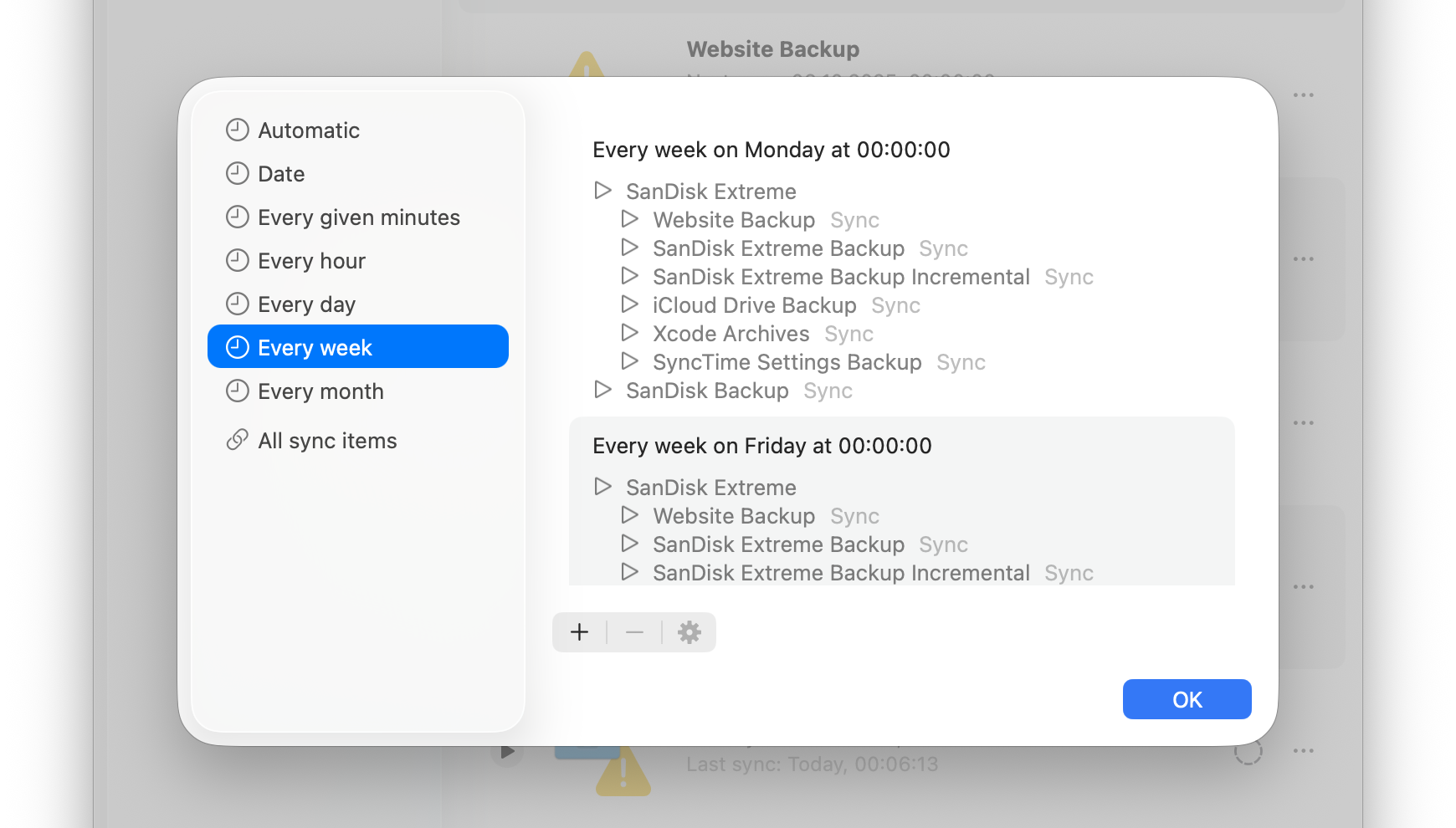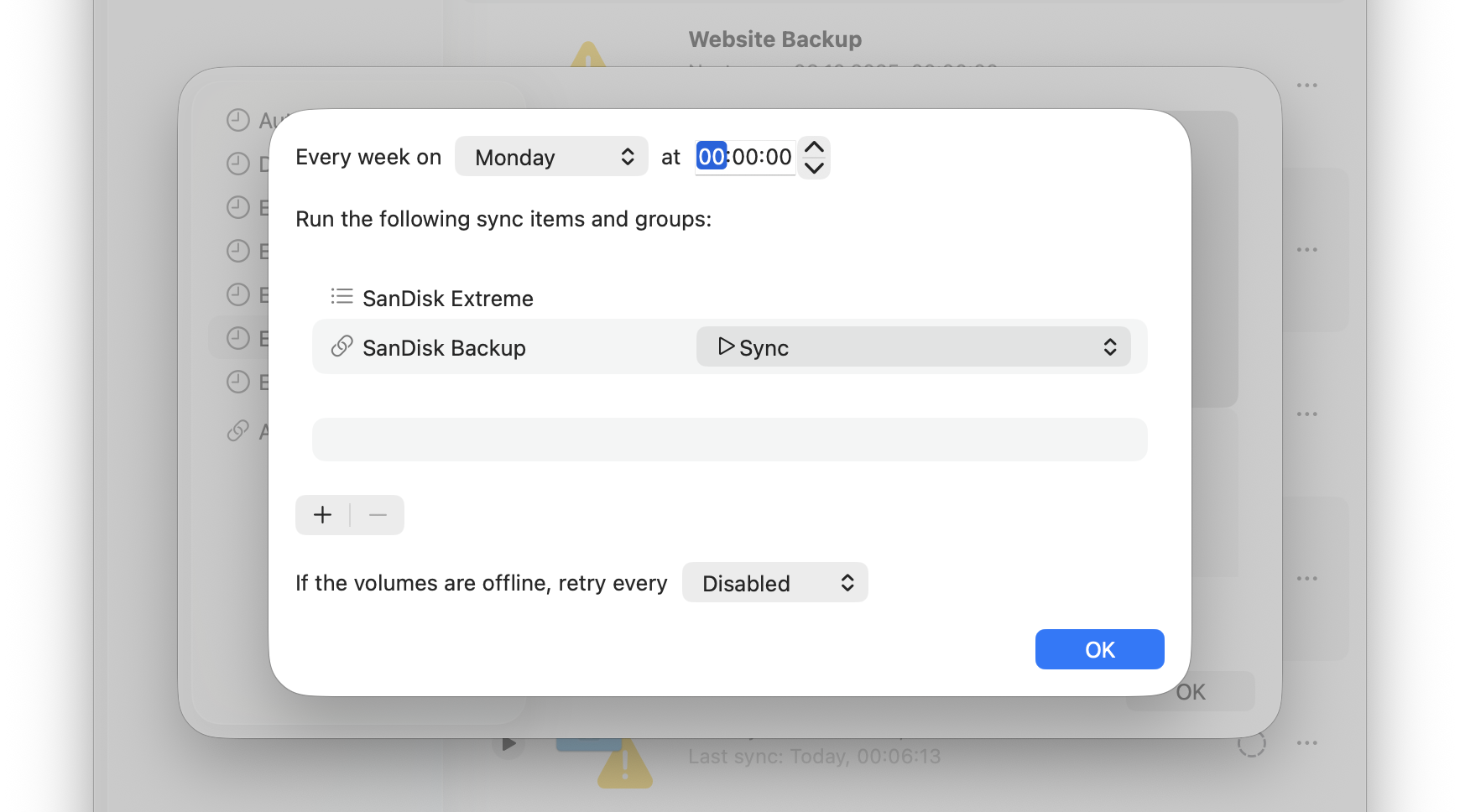Schedules allow sync items and sync groups to run automatically at specified dates and times or when the source and destination volumes become available.
For sync items, a schedule allows to select which action to run:
- Sync
- Sync and Compare File Contents
- Verify Backup
For information about the last two actions, see Verify backups.
To view and modify schedules, click the button with the clock icon in the toolbar, or select Window > Sync Schedule in the main menu.
To add a schedule, select a category in the sidebar and click the + button in the main area.
You can edit an existing schedule by double-clicking it, or by selecting it and then pressing the edit button below the table.

- Automatic: the sync runs whenever the bases become available. Once an automatic sync has been completed successfully, it will run again after at least one of the bases is unmounted and mounted again, the app is restarted, or the Mac wakes up from sleep.
- Date: the sync runs at a given date without showing the confirmation dialog. This sync schedule is removed automatically once the sync has completed.
- Every given minutes: the sync runs periodically with the given interval.
- Every hour: the sync runs every hour at a given number of minutes and seconds.
- Every day: the sync runs every day at a given time.
- Every week: the sync runs every given weekday at a given time.
- Every month: the sync runs every given day of the month at a given time.
To each schedule you can associate one or more sync items and/or groups.
Tip: to add several similar schedules, for example for different days of the week, you can create a schedule, then copy it with Command-C, paste it with Command-V, and edit the copy.

Reconnect interval
If one of the volumes is a remote server with unpredictable availability, or if there may be no internet connection at the scheduled time, you may set a reconnect interval: the sync is then rescheduled periodically, without logging any error, until a connection to the the volume is established.
Note: it is not necessary to set a reconnect interval for volumes that you actively connect to your Mac: SyncTime automatically detects when a volume is connected and starts a sync if necessary. The reconnect interval is only useful to connect to volumes (usually remote ones) that are not mounted automatically.
Next sync date
Sync items without a schedule show a label “Next sync: manual” above the last sync label.
When a sync item has one or more schedules, the label shows the next schedule after the last sync date.
When a sync item is part of one or more sync groups, it inherits the groups’ schedules, combining them with its own schedules. If a sync group has a recurring schedule, the next sync date of completed sync items in that group is set to the next estimated date, assuming that the remaining group steps are completed in time. If at that date the sync group is still in the running state (e.g. if a sync item prevents it from continuing because at least one base is unavailable), the already completed sync items are postponed to the next estimated date.
A sync item displays “Next sync: now” if the next schedule is in the past and the sync hasn’t run yet (e.g. because the bases are unavailable or it is waiting for the previous steps of a group to complete).
Considerations
- Unavailable volume: If one of the volumes is not available at the scheduled time, the sync item runs as soon as it becomes available.
- Cancelled sync item: Cancelling a sync item implicitly disables all schedules related to the sync item. To enable the schedules again, run the sync item manually.
- Unsuccessful sync: If one or more errors happen during a scheduled sync, the sync can be started again automatically at a later time to try to complete it successfully. Resolving all the errors makes sure that the sync is run according to plan.
- SyncTime not running: SyncTime needs to be running in order for schedules to be triggered. You can close the main window at any time while keeping the app running, and optionally hide the Dock icon from the status menu. Outdated schedules are run automatically at app launch.
Deactivate schedules temporarily
To temporarily suppress all schedules when starting SyncTime or connecting a volume, hold the Option key until you see the main SyncTime window or SyncTime has recognized the volume (the warning icon has been replaced by the volume icon).
